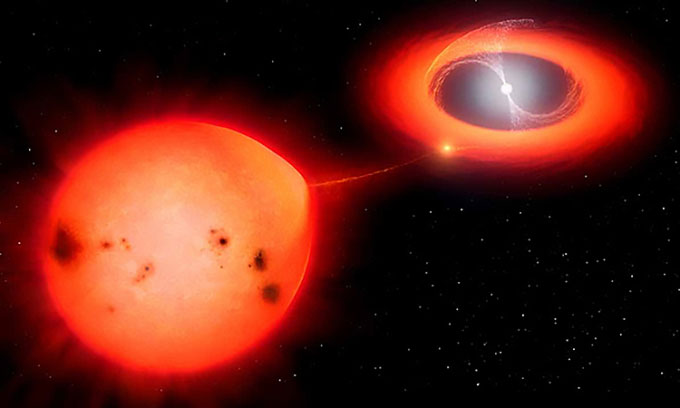A white dwarf in a binary star system is sucking up material from its “companion” and orbiting it in an extremely close orbit.
Discovered in images taken by the ZTF camera at the Palomar Observatory in California, this binary star system ZTF J1813 + 4251 lies about 3,000 light-years from Earth. It consists of a white dwarf and the remains of a red giant that orbits each other every 51 minutes, Space reported on October 7.

ZTF J1813+4251 is a prime example of a sudden variable star, in which the smaller white dwarf’s gravity is so strong that it “steals” gaseous matter from the hydrogen shell around its companion star. This gas then forms a bridge between the two objects and is eventually pulled into the white dwarf’s surface.
As the density of the accumulated matter increases, it ignites in a thermonuclear explosion called a nova. This event is not strong enough to destroy the star and occurs periodically, causing the system to light up unexpectedly and then fall back to a stationary state, hence the name “sudden variable star”.
Astronomer Kevin Burdge from the Massachusetts Institute of Technology in the US used an algorithm to search for sudden variable star systems through images of a billion stars captured by the ZTF instrument. The ZTF J1813+4251 system stands out because it’s also a strobe binary, meaning that when the two stars orbit each other, we can see one passing in front and dimming the luminosity of the two stars. the remaining star, causing the system to periodically flicker in the orbits of the stars.
Burdge and his team used the WM Keck Observatory in Hawaii and the Gran Telescopio Canarias in the Canary Islands to measure the star system’s precise mass, radius, and orbital period.
“The 51-minute orbital period is the shortest time seen for abruptly variable star systems,” the study states.
As the two stars of ZTF J1813 + 4251 moved closer, the white dwarf began to cannibalize the companion. It is a Sun-like star that has aged and evolved into a red giant. Its outer hydrogen layers swell and are easily stolen by the white dwarf. Over millions of years, so much hydrogen gas was pulled from the red giant, so much so that its helium-rich core was exposed.
The two stars are predicted to continue to approach each other for another 70 million years, and their orbital periods gradually decrease until the pair orbits each other in just 18 minutes. After that point, when accretion stops because the available gas is exhausted, the two will slowly drift apart.





